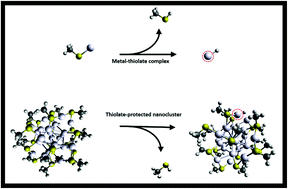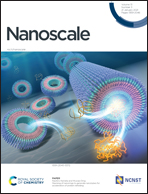Predicting ligand removal energetics in thiolate-protected nanoclusters from molecular complexes†
Abstract
Thiolate-protected metal nanoclusters (TPNCs) have attracted great interest in the last few decades due to their high stability, atomically precise structure, and compelling physicochemical properties. Among their various applications, TPNCs exhibit excellent catalytic activity for numerous reactions; however, recent work revealed that these systems must undergo partial ligand removal in order to generate active sites. Despite the importance of ligand removal in both catalysis and stability of TPNCs, the role of ligands and metal type in the process is not well understood. Herein, we utilize Density Functional Theory to understand the energetic interplay between metal–sulfur and sulfur–ligand bond dissociation in metal–thiolate systems. We first probe 66 metal–thiolate molecular complexes across combinations of M = Ag, Au, and Cu with twenty-two different ligands (R). Our results reveal that the energetics to break the metal–sulfur and sulfur–ligand bonds are strongly correlated and can be connected across all complexes through metal atomic ionization potentials. We then extend our work to the experimentally relevant [M25(SR)18]− TPNC, revealing the same correlations at the nanocluster level. Importantly, we unify our work by introducing a simple methodology to predict TPNC ligand removal energetics solely from calculations performed on metal–ligand molecular complexes. Finally, a computational mechanistic study was performed to investigate the hydrogenation pathways for SCH3-based complexes. The energy barriers for these systems revealed, in addition to thermodynamics, that kinetics favor the break of S–R over the M–S bond in the case of the Au complex. Our computational results rationalize several experimental observations pertinent to ligand effects on TPNCs. Overall, our introduced model provides an accelerated path to predict TPNC ligand removal energies, thus aiding towards targeted design of TPNC catalysts.

- This article is part of the themed collection: Editor’s Choice: Single-atom and nanocluster catalysis


 Please wait while we load your content...
Please wait while we load your content...